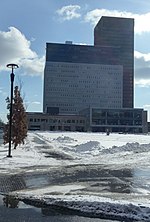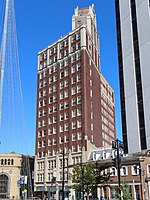Midtown Plaza (Rochester, New York)
1962 establishments in New York (state)2008 disestablishments in New York (state)Buildings and structures demolished in 2010Buildings and structures under construction in the United StatesCommercial buildings in Rochester, New York ... and 7 more
Defunct shopping malls in the United StatesDemolished buildings and structures in New York (state)Demolished shopping malls in the United StatesShopping malls disestablished in 2008Shopping malls established in 1962Shopping malls in New York (state)Victor Gruen buildings

Midtown Plaza is a city district in downtown Rochester, New York. The site was originally occupied by an indoor shopping mall designed by Victor Gruen and opened in 1962. Although it was primarily promoted as a retail space, Gruen's vision was for the plaza to function as an all-purpose community space to revitalize the downtown area. The original mall was closed in 2008 after a decline in retail activity and partially demolished. Since 2010 the site has been redeveloped with new buildings and an open lot known as Parcel 5.
Excerpt from the Wikipedia article Midtown Plaza (Rochester, New York) (License: CC BY-SA 3.0, Authors, Images).Midtown Plaza (Rochester, New York)
Cortland Street, City of Rochester
Geographical coordinates (GPS) Address Nearby Places Show on map
Geographical coordinates (GPS)
| Latitude | Longitude |
|---|---|
| N 43.15652 ° | E -77.6048 ° |
Address
Cortland Street
14604 City of Rochester
New York, United States
Open on Google Maps









